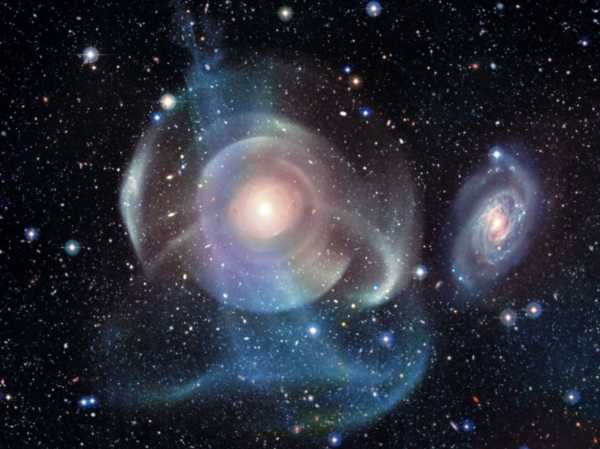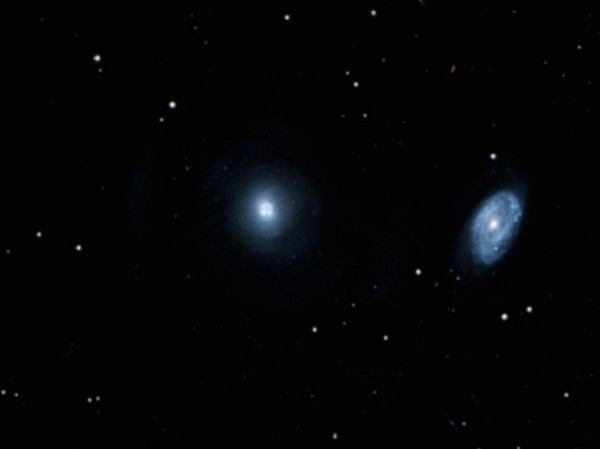When you look out at the Universe, it comes as no surprise that it's full of galaxies, each one with a dense, central collection of brilliant stars and an intricate structure all their own. They come in all sorts of structural varieties, with some in isolation, others in small groups, and still others in huge, massive clusters.
The bright galaxies we see are huge collections of billions of stars, with large intrinsic surface brightnesses. But surely there are components to these entities -- less dense regions -- that contain stars out hundreds of thousands of light-years beyond a galaxy's typical edge. Until recently, this was only theoretical, but all of that is beginning to change.
 The same pair of galaxies imaged to very low surface brightness with the MegaCam camera on CFHT. A complex and extended stellar halo consisting of stars of various ages (colors) is apparent. Image credit: Duc/Cuillandre/CFHT/Cole.
The same pair of galaxies imaged to very low surface brightness with the MegaCam camera on CFHT. A complex and extended stellar halo consisting of stars of various ages (colors) is apparent. Image credit: Duc/Cuillandre/CFHT/Cole.
Come read the whole story of the extended halos of stars around galaxies from James Bullock, and how they're helping to shed light on galactic evolution!


Isn't the fact that the dark matter theory works (slightly) bad at galactical scales caused by too limiting assumptions?
As far, as I know, the CDM theory assumes that:
- there is one kind of DM particle,
- self-interactions of DM particles are negligible,
- DM particles are in thermal equillibrum.
How changes predictions of CDM theory on galactical scales, if we assume that DM is formed of two or more particles with different masses (and maybe different temperature) or that in galaxies is DM so dense, that the interactions are not negligible?
Things can change if you alter the assumptions about dark matter, but you can't alter them in a way that will destroy the agreement on large scales. One possibility that people have started to look more closely at is the case of dark matter with strong self-interactions (not with normal matter, but strong interactions only with itself). This is an interesting possibility because it doesn't affect large scale structure, but can help things on small scales. It turns out that self-interacting dark matter also produces the same kind of mergers and streamy halos that this article talks about.
I should think that from a planet orbiting a star facing the galaxy flat side on, the Milky Way would be awesome sight at night.
James:
Of course that altering assumptions must not change large scale predictions. I am not an expert, but I guess (yes, it's only a guess) that relaxing that two assumptions wouldn't change the large scale predictions, as they change DM distribution on galactic scales but not on larger scales. I also understand, that we know (almost) nothing about DM, so we cannot use our imaginations without limits but I thing, that relaxing this two assumptions may be well motivated.
1. In SM there are three lightest massive particles that do not decay (as far as I know) to each other - three neutrinos. Why cannot DM have similar properties - the lightest DM particle of each generation cannot decay?
2. Anything interact with each else, so DM also has to interact with itself and at some DM density that interactions cannot be negligible.
However assumption about strong self-interacting DM is surprising for me. It need to assume some "dark electromagnetism" and although in some SUSY models, there is place for arbitrary many new U(1) interactions, I thought that physicists were rather skeptical about it.